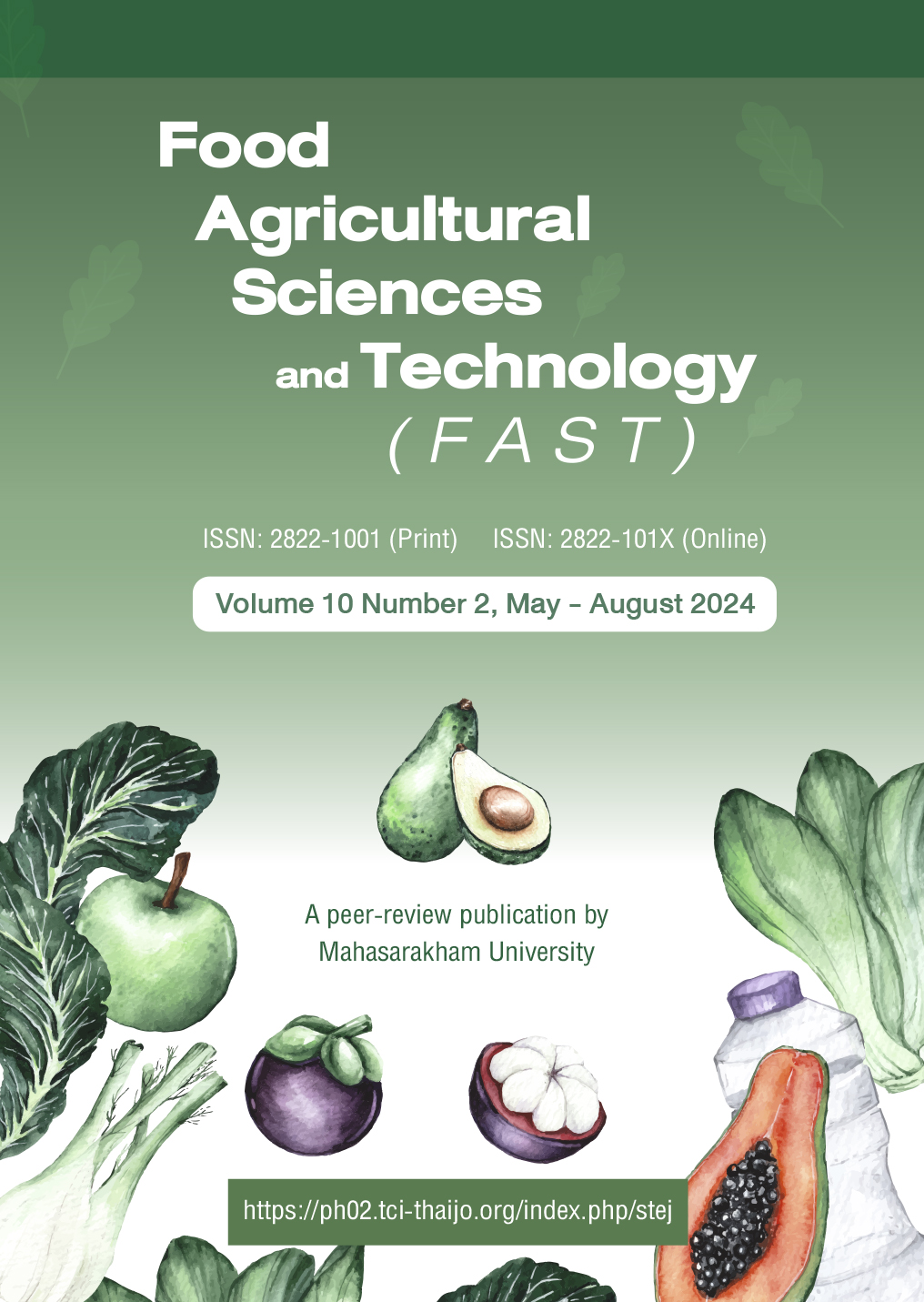Effect of grape seed extract as potent antioxidant on swelling properties and antioxidant activity of biocompatible carrageenan-based hydrogels
Keywords:
Hydrogels, carrageenan, grape seed extract, antioxidant activityAbstract
Grape seed extract has attracted a lot of interest as an effective natural antioxidant. It is extensively studied as it is rich in flavonoids, phenolic compounds, unsaturated fatty acids and vitamins showing particular promise in anti-inflammatory, anti-microbial, and anti-oxidative properties. We aim to highlight the effect of grape seed extract on the physicochemical properties and biological functions as antioxidant of an edible and biocompatible carrageenan-based hydrogels. The carrageenan-based hydrogels containing grape seed extract were prepared at various concentrations of grape seed extract (0-2% w/v) and two concentrations of glycerol (6% and 12% v/v). The k-carrageenan polysaccharide can be extracted from red edible seaweeds which has an ability to form gel with potential utilization in wound-healing products. The physical properties of carrageenan-based hydrogels were analyzed i.e. color, moisture content, swelling properties. In addition, the antioxidant properties of carrageenan-based hydrogels were studied as total phenolic content and % scavenging activity. Among 6 formulae, the results reported their percentages of opacity, moisture contents and swelling properties were 99-100%, 9-12%, and 14-29%, respectively. For antioxidant activities, the highest total phenolic content at 21.8 mg gallic acid equivalents per mL and scavenging activity (%) at 87.8% with 2% grape seed extract. The findings suggest that grape seed extract holds promise as an active ingredient in carrageenan hydrogel formulation, offering potential benefits for pharmaceutical purposes.
References
Adjimani, J. P., & Asare, P. (2015). Antioxidant and free radical scavenging activity of iron chelators. Toxicology Reports, 2, 721-728. https://doi. org/10.1016/j.toxrep.2015.04.005
Ajit, A., Vishnu, A. G., & Varkey, P. (2021). Incorporation of grape seed extract towards wound care product development. 3 Biotech, 11(6), 261. https://doi.org/10.100 7%2Fs13205-021-02826-4
Aksoy, L., Kolay, E., Ağılönü, Y., Aslan, Z., & Kargıoğlu, M. (2013). Free radical scavenging activity, total phenolic content, total antioxidant status, and total oxidant status of endemic Thermopsis turcica. Saudi Journal of Biological Sciences, 20(3), 235-239. https://doi.org/10.1016/j. sjbs.2013.02.003
Anseth, K. S., Bowman, C. N., & BrannonPeppas, L. (1996). Mechanical properties of hydrogels and their experimental determination. Biomaterials, 17(17), 1647-1657. https://doi.org/10.1016/0142- 9612(96)87644-7
Beltran, S., Baker, J. P., Hooper, H. H., Blanch, H. W., & Prausnitz, J. M. (1991). Swelling equilibria for weakly ionizable, temperature-sensitive hydrogels. Macromolecules, 24(2), 549-551. https://doi.org/10.1021/ ma00002a032
Bhattacharyya, T., Palla, C. S., Dethe, D. H., & Joshi, Y. M. (2024). Rheological investigation of the network structure in mixed gels of Kappa and Iota Carrageenan. Food Hydrocolloids, 146, 109298. https://doi.org/10.1016/j.foodhyd. 2023.109298
Bialik-Wąs, K., Pluta, K., Malina, D., Barczewski, M., Malarz, K., & Mrozek-Wilczkiewicz, A. (2021). The effect of glycerin content in sodium alginate/poly (vinyl alcohol)-based hydrogels for wound dressing application. International Journal of Molecular Sciences, 22(21), 12022.
Bustamante-Torres, M., Romero-Fierro, D., Arcentales-Vera, B., Palomino, K., Magaña, H., & Bucio, E. (2021). Hydrogels classification according to the physical or chemical interactions and as stimuli-sensitive materials. Gels, 7(4), 182. https:// www.mdpi.com/2310-2861/7/4/182
Byrne, M. E., Park, K., & Peppas, N. A. (2002). Molecular imprinting within hydrogels. Advanced Drug Delivery Reviews, 54(1), 149-161. https://doi.org/10.1016/S0169- 409X(01)00246-0
Byrne, M. E., & Salian, V. (2008). Molecular imprinting within hydrogels II: Progress and analysis of the field. International Journal of Pharmaceutics, 364(2), 188-212.
Campo, V. L., Kawano, D. F., da Silva Jr, D. B., & Carvalho, I. (2009). Carrageenans: Biological properties, chemical modifications and structural analysis-A review. Carbohydrate Polymers, 77(2), 167-180. https://doi.org/10.1016/j. ijpharm.2008.09.002
Coupland, J. N., Shaw, N. B., Monahan, F. J., O’Riordan, E. D., & O’Sullivan, M. (2000). Modeling the effect of glycerol on the moisture sorption behavior of whey protein edible films. Journal of Food Engineering, 43(1), 25-30. https://www. sciencedirect.com/science/article/ abs/pii/S0260877499001296
Chen, B., Ivanov, I., Klein, M. L., & Parrinello, M. (2003). Hydrogen bonding in water. Physical Review Letters, 91(21), 215503. https://doi. org/10.1103/PhysRevLett.91.215503
Dalei, G., Jena, M., Jena, D., Pattanaik, C., Das, B. R., & Das, S. (2024). Fabrication of cucumber peel extract-imbued dragon fruit peel pectin hydrogel packaging films: Assessment in preservation of chicken meat. Polymer Engineering & Science, 64(3), 1391-1403 https:// doi.org/10.1002/pen.26624
De Carvalho, R. A., & Grosso, C. R. F. (2006). Properties of chemically modified gelatin films. Brazilian Journal of Chemical Engineering, 23, 45-53. doi: 10.1590/S0104- 66322006000100006
De Oliveira, J. P., Bruni, G. P., Lima, K. O., El Halal, S. L. M., da Rosa, G. S., Dias, A. R. G., & da Rosa Zavareze, E. (2017). Cellulose fibers extracted from rice and oat husks and their application in hydrogel. Food Chemistry, 221, 153-160.
Deng, Z., Zhu, J., Chen, Y., Zhong, N., Huang, C., & Hu, Y. (2024). Controlled release of dual food functional ingredients from octenyl succinic anhydride/β-cyclodextrin nanoparticles integrated carrageenan/ polyvinyl alcohol hydrogels. Journal of Molecular Liquids, 393, 123646. https://doi.org/10.1016/j. molliq.2023.123646
Diah, A. W. M., Raihan, M. F., Rahmawati, S., Ningsih, P., & Nuryanti, S. (2022). The antioxidant activities of acid hydrolysis of κ-Carrageenan. Rasayan Journal of Chemistry, 15(1). doi: 10.31788/RJC.2022.1516556
Ding, B., Zeng, P., Huang, Z., Dai, L., Lan, T., Xu, H., & Liu, B. (2022). A 2D material-based transparent hydrogel with engineerable interference colours. Nature Communications, 13(1), 1212. https://doi.org/10.1038/s41467- 021-26587-z
Faki, R., Gursoy, O., & Yilmaz, Y. (2019). Effect of electrospinning process on total antioxidant activity of electrospun nanofibers containing grape seed extract. Open Chemistry, 17(1), 912-918. doi:10.1515/ chem-2019-0098
Fluhr, J. W., Darlenski, R., & Surber, C. J. B. J. (2008). Glycerol and the skin: holistic approach to its origin and functions. British Journal of Dermatology, 159(1), 23-34. https://doi.org/10.1111/j.1365- 2133.2008.08643.x
Freitas, V. A. P. D., & Glories, Y. (1999). Concentration and compositional changes of procyanidins in grape seeds and skin of white Vitis vinifera varieties. Journal of the Science of Food and Agriculture, 79(12), 1601-1606. https:// doi.org/10.1002/(SICI)1097- 0010(199909)79:12<1601:: AID-JSFA407>3.0.CO;2-1
Garcia, C. F., Martins, V. C., & Plepis, A. M. (2019). Effects of grape seed extract on properties of type I collagen scaffolds. International Journal of Advances in Medical Biotechnology-IJAMB, 2(2), 2-10. https://doi.org/10.25061/2595-3931/ IJAMB/2019.v2i2.29
Garcia, V. S., Gugliotta, L. M., Gutierrez, C. G., & Gonzalez, V. D. (2024). κ-Carrageenan Hydrogels as a Sustainable Alternative for Controlled Release of New Biodegradable Molecules with Antimicrobial Activities. Journal of Polymers and the Environment, 1-15. https://doi.org/10.1007/ s10924-024-03189-6
Gesslein, B. W. (1999). Humectants in personal care formulation: a practical guide. In Conditioning agents for hair and skin (pp. 95-96). Marcel Dekker.
Gong, J. P., Katsuyama, Y., Kurokawa, T., & Osada, Y. (2003). Double-network hydrogels with extremely high mechanical strength. Advanced Materials, 15(14), 1155-1158. https:// doi.org/10.1002/adma.200304907
Gupta, M., Dey, S., Marbaniang, D., Pal, P., Ray, S., & Mazumder, B. (2020). Grape seed extract: Having a potential health benefits. Journal of Food Science and Technology, 57, 1205-1215. https://doi.org/10.1007/ s13197-019-04113-w
Jakubczyk, E., Kamińska-Dwórznicka, A., Ostrowska-Ligęza, E. (2022). The effect of composition, pre-treatment on the mechanical and acoustic properties of apple gels and freeze-dried materials. Gels, 8, 110. https://doi.org/10.3390/ gels8020110
Jangdey, R., Singh, M. R., & Singh, D. (2024). Natural hydrogels: synthesis, composites, and prospects in wound management. In hydrogels for tissue engineering and regenerative medicine (pp. 29-63). Academic Press. https://doi.org/10.1016/ B978-0-12-823948-3.00011-7
Jayakody, M. M., Kaushani, K. G., Vanniarachchy, M. P. G., & Wijesekara, I. (2023). Hydrocolloid and water soluble polymers used in the food industry and their functional properties: a review. Polymer Bulletin, 80(4), 3585- 3610. https://link.springer.com/ article/10.1007/s00289-022-04264-5
Jin, S., Newton, M. A. A., Cheng, H., Zhang, Q., Gao, W., Zheng, Y. & Zhu, J. (2023). Progress of hydrogel dressings with wound monitoring and treatment functions. Gels, 9(9), 694. https://doi.org/10.3390/ gels9090694
Kakkar, V., & Narula, P. (2022). Role of molecularly imprinted hydrogels in drug delivery-A current perspective. International Journal of Pharmaceutics, 121883. https://doi. org/10.1016/j.ijpharm.2022.121883
Kamath, K. R., & Park, K. (1993). Biodegradable hydrogels in drug delivery. Advanced Drug Delivery Reviews, 11(1-2), 59-84. https://doi. org/10.1016/0169-409X(93)90027-2
Koneru, A., Dharmalingam, K., & Anandalakshmi, R. (2020). Cellulose based nanocomposite hydrogel films consisting of sodium carboxymethylcellulose-grapefruit seed extract nanoparticles for potential wound healing applications. International Journal of Biological Macromolecules, 148, 833-842. https://doi.org/10.1016/j.ijbiomac. 2020.01.018
Kopač, T., Abrami, M., Grassi, M., Ručigaj, A., & Krajnc, M. (2022). Polysaccharide-based hydrogels crosslink density equation: A rheological and LF-NMR study of polymer-polymer interactions. Carbohydrate Polymers, 277, 118895. https://doi.org/10.1016/j. carbpol.2021.118895
Kozlowska, J., Pauter, K., & Sionkowska, A. (2018). Carrageenan-based hydrogels: Effect of sorbitol and glycerin on the stability, swelling and mechanical properties. Polymer Testing, 67, 7-11. https:// doi.org/10.1016/j.polymertesting. 2018.02.016
Kwatra, B. (2020). A review on potential properties and therapeutic applications of grape seed extract. World Journal of Pharmaceutical Research, 9, 2519-2540. doi: 10.20959/wjpr20205-17514
Lawag, I. L., Nolden, E. S., Schaper, A. A., Lim, L. Y., & Locher, C. (2023). A modified folin-ciocalteu assay for the determination of total phenolics content in honey. Applied Sciences, 13(4), 2135. https://doi. org/10.3390/app13042135
Li, X., & Su, X. (2018). Multifunctional smart hydrogels: Potential in tissue engineering and cancer therapy. Journal of Materials Chemistry B, 6(29), 4714-4730. https://doi. org/10.1039/C8TB01078A
Locilento, D. A., Mercante, L. A., Andre, R. S., Mattoso, L. H., Luna, G. L., Brassolatti, P. & Correa, D. S. (2019). Biocompatible and biodegradable electrospun nanofibrous membranes loaded with grape seed extract for wound dressing application. Journal of Nanomaterials, 2019. https:// doi.org/10.1155/2019/2472964
Ma, H., Zhou, Q., Chang, J., & Wu, C. (2019). Grape seed-inspired smart hydrogel scaffolds for melanoma therapy and wound healing. ACS Nano, 13(4), 4302-4311. https:// doi.org/10.1021/acsnano.8b09496
Ma, Z. F., & Zhang, H. (2017). Phytochemical constituents, health benefits, and industrial applications of grape seeds: A mini-review. Antioxidants, 6(3), 71. ttps://doi.org/10.3390/ antiox6030071
Mahinroosta, M., Farsangi, Z. J., Allahverdi, A., & Shakoori, Z. (2018). Hydrogels as intelligent materials: A brief review of synthesis, properties and applications. Materials Today Chemistry, 8, 42-55. https://doi. org/10.1016/j.mtchem.2018.02.004
Mano, J. F., Silva, G. A., Azevedo, H. S., Malafaya, P. B., Sousa, R. A., Silva, S. S. & Reis, R. L. (2007). Natural origin biodegradable systems in tissue engineering and regenerative medicine: present status and some moving trends. Journal of the Royal Society Interface, 4(17), 999-1030. https://doi.org/10.1098/ rsif.2007.0220
Memar, M. Y., Adibkia, K., Farajnia, S., Kafil, H. S., Yekani, M., Alizadeh, N., & Ghotaslou, R. (2019). The grape seed extract: A natural antimicrobial agent against different pathogens. Reviews and Research in Medical Microbiology, 30(3), 173-182. doi: 10.1097/MRM.0000000000000174
Mokhtari, H., Tavakoli, S., Safarpour, F., Kharaziha, M., Bakhsheshi-Rad, H. R., Ramakrishna, S., & Berto, F. (2021). Recent advances in chemically-modified and hybrid carrageenan-based platforms for drug delivery, wound healing, and tissue engineering. Polymers, 13(11), 1744. doi: 10.3390/polym13111744
Merck Index, O’neil, M. J., Heckelman, P., & Koch, C. (2006). The Merck index. Whitehouse Station Merck & Co.
Nakipoglu, M., Özkabadayı, Y., Karahan, S., & Tezcaner, A. (2024). Bilayer wound dressing composed of asymmetric polycaprolactone membrane and chitosan-carrageenan hydrogel incorporating storax balsam. International Journal of Biological Macromolecules, 254, 128020. https://doi.org/10.1016/j. ijbiomac.2023.128020
Nallathambi, R., Poulev, A., Zuk, J. B., & Raskin, I. (2020). Proanthocyanidin-rich grape seed extract reduces inflammation and oxidative stress and restores tight junction barrier function in Caco-2 colon cells. Nutrients, 12(6), 1623. https://doi.org/10.3390/nu12061623
Pleuvry, B. J. (2008). Drugs acting by causing physicochemical changes in the environment. Anaesthesia & Intensive Care Medicine, 9(4), 163-164. https://doi.org/10.1016/j. mpaic.2008.02.003
Premjit, Y., Pandey, S., & Mitra, J. (2024). Encapsulation of probiotics in freeze-dried calcium alginate and κ-carrageenan beads using definitive screening design: A comprehensive characterisation and in vitro digestion study. International Journal of Biological Macromolecules, 129279. https://doi.org/10.1016/j. ijbiomac.2024.129279
Qureshi, M. A. U. R., Arshad, N., Rasool, A., Islam, A., Rizwan, M., Haseeb, M., & Bilal, M. (2024). Chitosan and carrageenan-based biocompatible hydrogel platforms for cosmeceutical, drug delivery, and biomedical applications. Starch-Stärke, 76 (1-2), 2200052.
Rajakumari, R., Volova, T., Oluwafemi, O. S., Rajesh Kumar, S., Thomas, S., & Kalarikkal, N. (2020). Grape seed extract-soluplus dispersion and its antioxidant activity. Drug Development and Industrial Pharmacy, 46(8), 1219-1229. https://doi.org/10.1080/0363904 5.2020.1788059
Ribeiro, A., Estanqueiro, M., Oliveira, M., & Sousa Lobo, J. (2015). Main benefits and applicability of plant extracts in skin care products. Cosmetics, 2(2), 48-65. https://doi. org/10.3390/cosmetics2020048
Rode, M. P., Batti Angulski, A. B., Gomes, F. A., da Silva, M. M., Jeremias, T. D. S., de Carvalho, R. G., & Calloni, G. W. (2018). Carrageenan hydrogel as a scaffold for skin-derived multipotent stromal cells delivery. Journal of Biomaterials Applications, 33(3), 422-434. https:// doi.org/10.1177/0885328218795569
Samiei, M., Fathi, M., Barar, J., Fathi, N., Amiryaghoubi, N., & Omidi, Y. (2021). Bioactive hydrogel-based scaffolds for the regeneration of dental pulp tissue. Journal of Drug Delivery Science and Technology, 64, 102600. https://doi.org/10.1016/j. jddst.2021.102600
Shafie, M. H., Kamal, M. L., Zulkiflee, F. F., Hasan, S., Uyup, N. H., Abdullah, S. & Zafarina, Z. (2022). Application of carrageenan extract from red seaweed (Rhodophyta) in cosmetic products: A review. Journal of the Indian Chemical Society, 99(9), 100613. https://doi. org/10.1016/j.jics.2022.100613
Watcharin, W., Gupta, S., Saning, A., Laodheerasiri, S., & Chuenchom, L. (2023). Free radical scavenging effects of grapefruit essential oil nanoemulsion stabilized with carrageenan and its cytotoxicity assay on HeLa cell line. Advances in Natural Sciences: Nanoscience and Nanotechnology, 14(2), 025014. doi 10.1088/2043-6262/acd6e5
Wei, D., Zhu, X. M., Chen, Y. Y., Li, X. Y., Chen, Y. P., Liu, H. Y., & Zhang, M. (2019). Chronic wound biofilms: diagnosis and therapeutic strategies. Chinese Medical Journal, 132(22), 2737-2744. https:// mednexus.org/doi/full/10.1097/ CM9.0000000000000523
Wichterle, O., & Lím, D. (1960). Hydrophilic gels for biological use. Nature, 185, 117-118.
Downloads
Published
How to Cite
Issue
Section
License
Copyright (c) 2024 Food Agricultural Sciences and Technology

This work is licensed under a Creative Commons Attribution-NoDerivatives 4.0 International License.







